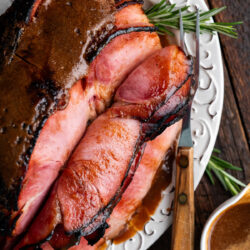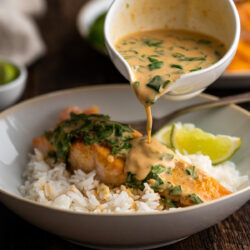This delicious Singapore Noodles recipe (also known as Mei Fun) is filled with shrimp, Char Siu, veggies, rice noodles, and spices that make the perfect Asian dish!

The first time I tried Singapore Noodles (Singapore Mei Fun) was in London when I had a craving for some delicious Asian flavors. Then after having this dish, I knew I had to recreate it. This recipe combines all my favorite Asian ingredients into one dish, and it’s perfect for leftovers throughout the week!
Table of Contents
Why We Love This Recipe
- The mix of meats, vegetables, and noodles offers a delightful array of textures and flavors in every bite.
- Singapore Noodles are easily customizable with available ingredients.
- The spices used bring a warm, aromatic essence that makes the dish inviting and delicious.
- With a variety of meats or seafood options, it’s packed with proteins.
Recipe Ingredients

- Dried Vermicelli Rice Noodles: These noodles offer a neutral base. They absorb the rich flavors of our Singapore Noodles recipe while providing a satisfying, slightly chewy texture.
- Char Siu (Chinese BBQ Pork): Infuses a delightful blend of sweet and smoky flavors. Don’t forget to explore my Char Siu recipe. If you’re short on time, you don’t have to use the Chinese BBQ Pork, but I can assure you it adds the perfect flavor to the dish.
- Napa Cabbage: This ingredient offers a refreshing, crisp contrast to the savory and umami flavors in the dish.
See the recipe card for full information on ingredients and quantities.
Variations
- Gluten-Free: Replace soy sauce with tamari and ensure curry powder and chicken stock are gluten-free. Choose gluten-free Shaoxing wine or sherry.
- Vegan: Omit eggs and shrimp. Use tofu or tempeh instead of BBQ pork. Substitute chicken stock with vegetable stock.
- Vegetarian: Add thin strips of extra vegetables or tofu for protein. Ensure that other ingredients like stock are vegetarian. Consider including bean sprouts, red bell peppers, and snow peas for added flavor and texture.
- Spicier Version: Add more dried red chili peppers or a dash of hot sauce to elevate the heat in the dish.
- Low-Carb: Replace rice noodles with spiralized vegetables like zucchini or carrot noodles to reduce the carbohydrate content. Adjust cooking times as needed.

How To Make Singapore Noodles
Step #1: Rehydrate the rice vermicelli noodles by soaking in hot water for 30 minutes or boiling for 1 minute.
Step #2: Drain the noodles in a colander right before you are ready to cook. Be sure to cut any long strands to about 8 inches so it is easier to cook and eat.

Step #3: Heat your wok over medium heat and add 1 tablespoon of oil. Beat the two eggs and add them into the wok. When they have cooked and bubbled along the sides, flip them over and break the eggs up into strips with your spatula. Remove them from the wok and set aside.

Step #4: With an empty wok again, add the remaining 1 ½ tablespoons of oil and the garlic. Cook for 15 seconds and add the thawed shrimp and roast pork. Cook for another 15 seconds.
Step #5: Add the Shaoxing wine around the side of the wok and cook for another 15 seconds.
Step #6: Then, add in your carrots, dried red chili peppers, red onion, and Napa cabbage. Stir-fry for 30 seconds.

Step #7: After this, you can add in your hydrated rice noodles. Cook for one minute and continue lifting the rice noodles to break them apart and loosen them.

Step #8: Next, add the curry powder, salt, and white pepper evenly over the noodles.

Step #9: Turn up the heat to high. Use a scoop and lift motion on the dish and cook for about 2 minutes. Ensure all the ingredients combine together, and you can see the curry coloring the noodles.

Step #10: If the dish starts to get dry, you can add in tablespoons of chicken stock to keep it from drying out.
Step #11: Add the sesame oil, soy sauce, and cooked eggs and mix together for another minute. Finally, add the scallions and cook for another 15 seconds. Serve and enjoy!

Expert Tips
- Noodle Softening: Soak the rice vermicelli noodles just until they are soft enough to work with. This prevents them from becoming too mushy when stir-fried.
- Heat Management: Ensure the pan is hot enough before adding ingredients. Maintain a high heat to achieve a delightful sear on the ingredients without overcooking. Adjust the heat if necessary.
- Stir-Frying Order: Cook the ingredients in batches and in the correct order. Usually, proteins are first, followed by vegetables, and then combined with noodles and sauces.
- Use a Seasoned Wok or a Large Frying Pan: These pans spread heat evenly and add a special smoky flavor called ‘wok hei,’ which is common in Chinese dishes. If you need a wok, you can get this very affordable wok.
- Keep Some Broth or Water Handy: This is crucial if the noodles start sticking to the wok or if the dish gets too dry. A little bit of liquid can help loosen things up.
Frequently Asked Questions
Mei fun, also known as rice vermicelli, uses thin rice noodles, which cook quickly and are light in texture. Its delicate nature enhances the taste of the dish, making it a popular choice in Hong Kong.
Lo Mein, on the other hand, uses thicker wheat noodles, resulting in a chewier and more substantial texture. Both dishes can include various vegetables and proteins, with the option of tossing them in a flavorful sauce to further enhance their taste. The choice of noodles distinguishes these two delicious Chinese dishes.
The healthiness of Singapore chow mein depends on the ingredients and preparation. You can make it with a variety of vegetables and protein sources.
Yes, you can make this recipe without a wok; a large skillet or frying pan will work.
Yes, you can omit the eggs in this recipe for a vegan or egg-free version.

Storage Info
For storing Singaporean noodles, first, let them cool. Then, place them in an airtight container or zip-lock bag. In the refrigerator, they’ll last 3-4 days. For longer storage, freeze them, ensuring a tight seal to prevent freezer burn; they’ll be good for up to 2 months.
To reheat, if frozen, thaw overnight in the refrigerator. Microwave or stovetop methods work well. If using a stovetop, add a touch of oil or water to maintain moisture. Ensure the noodles reach at least 165°F (74°C) when reheating for safe consumption.
More Recipes That You Will Love

Singapore Noodles Recipe (Mei Fun Recipe)
RECOMMENDED PRODUCTS
Ingredients
- 8 oz. Dried Vermicelli rice noodles
- 8 oz. Frozen Shrimp - peeled and deveined
- 8 oz. Char Siu - Chinese BBQ Pork
- 2 Eggs
- 2 ½ Tablespoons Vegetable Oil
- 2 cloves garlic
- 3 dried red chili peppers
- 4 cups Napa cabbage
- 2 Medium-Large Carrots; julienned
- ½ of a red onion; thinly sliced
- 1 Tablespoon Shaoxing Wine - can substitute dry cooking sherry
- 2 Tablespoons curry powder
- 1 teaspoon salt
- ¼ teaspoon sugar
- ⅛ teaspoon white pepper
- 2-4 Tablespoons chicken stock - if needed
- ½ teaspoon sesame oil
- 1 ½ teaspoons soy sauce
- 2 scallions
Instructions
- Rehydrate the noodles by soaking in hot water for 30 minutes or boiling for 1 minute.
- Drain the noodles in a colander right before you are ready to cook. Be sure to cut any long strands to about 8 inches so it is easier to cook and eat.
- Heat your wok over medium heat and add 1 tablespoon of oil. Beat the two eggs and add them into the wok. When they have cooked and bubbled along the sides, flip them over and break the eggs up into strips with your spatula. Remove them from the wok and set aside.
- With an empty wok again, add the remaining 1 ½ tablespoons of oil and the garlic. Cook for 15 seconds and add the thawed shrimp and roast pork. Cook for another 15 seconds.
- Add the Shaoxing wine around the side of the wok and cook for another 15 seconds.
- Then, add in your carrots, dried red chili peppers, red onion, and Napa cabbage. Stir-fry for 30 seconds.
- After this, you can add in your hydrated rice noodles. Cook for one minute and continue lifting the rice noodles to break them apart and loosen them.
- Next, add the curry powder, salt, and white pepper evenly over the noodles.
- Turn up the heat to high. Use a scoop and lift motion on the dish and cook for about 2 minutes. Ensure all the ingredients combine together, and you can see the curry coloring the noodles.
- If the dish starts to get dry, you can add in tablespoons of chicken stock to keep it from drying out.
- Add the sesame oil, soy sauce, and cooked eggs and mix together for another minute. Finally, add the scallions and cook for another 15 seconds. Serve and enjoy!
VIDEO
NOTES
Nutrition














